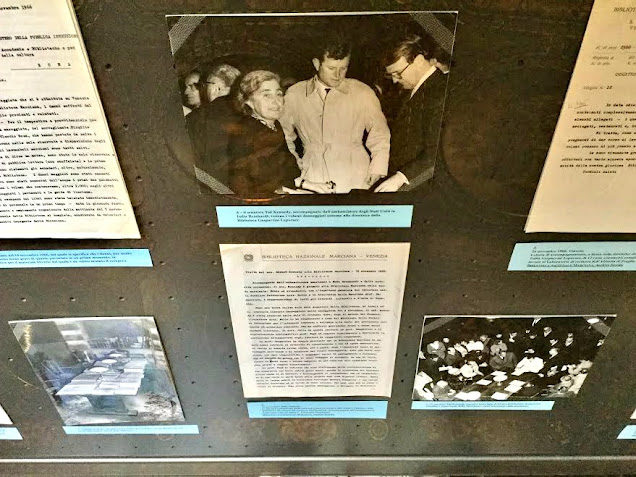 |
| Unde Origo Inde Salus MDCXXXI in Church of Madonna della Salute - Photo: Cat Bauer |
The rose mosaic is under the enormous chandelier in the center of the dome. In the mosaic is a bronze circle engraved with the words Unde Origo Inde Salus MDCXXXI, which means "From the origin comes salvation, 1631."
The Church of Madonna della Salute was built in thanks for ending the plague of 1630-31, and dedicated to the Madonna, under whose protection Venice was created in the first place -- or so the story goes -- so it made sense to ask her for help.
And on the high altar, in all her glory, is the Madonna, who happens to be Black.
In 2013, I wrote an in-depth post about the Black Madonna and the Festa della Salute, which I will share with you again. And for everyone all over the world that is freaking out over the US presidential election, I strongly suggest you ask the Black Madonna for a little help. Happy Thanksgiving!
Festa of the Madonna della Salute
(Venice, Italy) During the fifteen years I've lived in Venice, I have rarely missed the Festa of the Madonna della Salute on November 21. Most of the city, and much of the Veneto, makes the trek over the pontoon bridge from Santa Maria del Giglio next to the Hotel Gritti Palace and over to the Church of the Salute on Punta della Dogna to light a candle (or two or three) so that the Beloved Black Madonna will protect our health.
The plague first struck Venice in 1575. Desperate for relief, in 1577 the Venetian Senate decided to build a church in honor of Christ the Redeemer if God would end the plague. That worked (for a while), and the city of Venice has the magnificent Church of Redentore to show for it.
Unfortunately, the plague returned only 55 years later, so Doge Nicolò Contarini and the boys decided to build another church, this time pleading to the Virgin Mary for help. After all, the Republic of Venice was feminine, and under the Madonna's rule -- or so the story goes. On October 22, 1630, Contarini ordained the church be built; the 26-year-old architect Baldassare Longhena won the competition to design it; work started in 1631 and was finished in 1687. Longhena wrote:
"I have created a church in the form of a rotunda, a work of new invention, not built in Venice, a work very worthy and desired by many. This church, having the mystery of its dedication, being dedicated to the Blessed Virgin, made me think, with what little talent God has bestowed upon me of building the church in the ... shape of a crown."
The centerpiece of the awesome Salute Church is the Panagia Mesopantitisa, a very wise Byzantine Black Madonna, who never fails to fill me with deep emotion. The Panagia Mesopantitisa gets all dolled up for the occasion, and puts on her finest jewels. If we can understand where she comes from, perhaps we can understand why the Venetians built such an impressive church.
 |
| Madonna della Salute in all her finery - Photo: Cat Bauer |
The city is now named Heraklion, and is again part of Greece, and that is where the Eastern Orthodox Black Madonna named Panagia Mesopantitisa comes from. I like to think that the Venetians of that era might have been a little sorry for the part their ancestors played in the Fourth Crusade by giving her such an honor.
From the Venice Comune:
"The Festa della Salute is probably the least "touristy" of the Venetian festivities and evokes strong religious feelings among the city's inhabitants.
The holiday is, like the Redentore, in memory of another bout of pestilence, which lasted for two years from 1630-31, and the subsequent vow by the Doge to obtain the intercession of the Virgin Mary.
Even today, thousands of inhabitants visit the main altar of the imposing Salute Church on November 21 to give thanks, and a strong symbolic tie remains between the city and the Virgin Mary."
 |
| Wood carving on seat - right |
Next I always stand directly in the circle beneath enormous light fixture that dangles directly from the center of the church and get one of my power charges for the year.
 |
| Wood carving on seat - left |
The crowd surges against the high altar until the young guards controlling the scene allow everyone to pass. You then wander back through the Sacristy, where you can buy little prayer cards and rosaries and gaze upon precious art by Titian and Tintoretto, and the first Pope John Paul's vestments -- who was, of course, Venetian, and died after only 33 days as Pope. For some reason, seeing the sweet Papa's actual clothes made me teary-eyed.
Then everyone pours back out down the steps and over to the endless stalls of sweets from Sicily and enormous balloons for the kids -- for Festa della Salute is a day when every kid in Venice proudly marches through the city clutching their carefully-chose balloon.
One great thing about living in a Catholic country is that there are many miracles and White Magic floating through the air, and Venice definitely has its own interpretations and rituals. So far, the Madonna della Salute has worked her magic, and kept me healthy and protected under extreme circumstances, so here is a little prayer to share:
Maria, salute degli infermi, prega per noi.
And remember, when your Republic really gets into trouble there is only one way out: SAY YOU'RE SORRY AND THEN BUILD A SPECTACULAR CHURCH GRAND ENOUGH TO CATCH THE EYE OF THE MADONNA OR JESUS CHRIST! It works!
Ciao from Venezia,
Cat Bauer
Venetian Cat -The Venice Blog






















